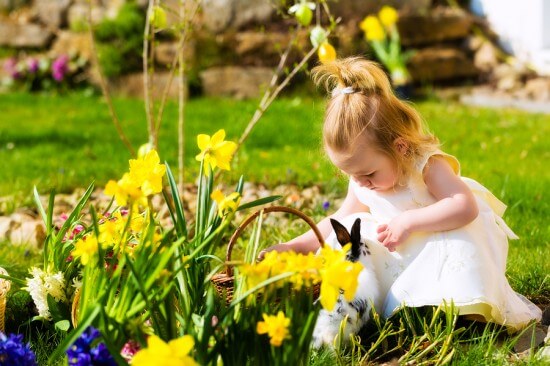
As Easter approaches it seems that bunnies begin to appear everywhere. While many people assume that Easter bunnies are simply a sign of spring and a signal that Easter will soon arrive there is actually an extensive history on the origins of the Easter bunny.
The central figure of Easter may be the Easter Bunny who is a mythological rabbit who carries eggs and candy to children in a basket on the Easter holiday. While the origin of the Easter bunny is disputed; some trace it to alleged pre-Christian fertility lore while others look to the role of the hare in Christian iconography.
The rabbit as an Easter symbol seems to have its origins in Alsace and South-West-Germany. The Easter bunny was first mentioned in German writings in the 1600s. The first edible Easter bunnies made from pastry and sugar and were introduced in the early 1800s in Germany. The Easter bunny made it’s debut in American folklore by the German settlers who arrived in the Pennsylvania Dutch country during the 1700s. The idea of an egg-laying bunny came to the United States sometime early in the 18th century. German immigrants in the Pennsylvania Dutch area told their children about the “Osterhas,” sometimes spelled “Oschter Haws.” “Hase” means “hare,” not rabbit, and in Northwest European folklore the “Easter Bunny” is a hare, not a rabbit. According to the legend, only good children would receive gifts of colored eggs in the nests that they made in their caps and bonnets before Easter. Jakob Grimm in 1835 wrote of long-standing similar myths in Germany itself. It was considered that the arrival of the “Oschter Haws” was considered “childhood’s greatest pleasure” next to a visit from Christ-Kindel on Christmas Eve. The children would excitedly build their nest in a secluded place in the home, the barn or the garden. In some communities boys would use their caps and girls their bonnets to make the nests. It was not until much later that the use of elaborate Easter baskets would come as the tradition of the Easter bunny spread throughout the country.
It is felt that the symbol of the bunny bringing eggs came about since eggs, like rabbits and hares, are fertility symbols from antiquity. Since birds lay the eggs and rabbits and hares give birth to large litters in the early spring, these would become symbols of the rising fertility of the earth at springtime.
There are also many legends and sayings that surround this time of year and spring or Easter bunny. The common saying “mad as a March hare” refers to the wild capers of hares as the males fight over the females in the early spring. Since the females often rebuff the males’ advances before finally succumbing, the mating behavior often looks like a crazy dance. These wild fights led early observers to believe that the advent of spring made the hares “mad.” This bold behavior makes the hares who are normally timid and retiring animals much more conspicuous to human observation in the spring. In addition since spring is known as the time of new life and renewal, bunnies have become symbolic of this since rabbits and hares are both prolific breeders. It is therefore not surprising that rabbits and hares should become fertility symbols, or that their springtime mating antics should enter into Easter folklore.
It is surprising to note that the Easter bunny is not welcomed everywhere. For example in Australia, the rapid spread of introduced rabbits has made them a major environmental pest, and feral rabbits are still a problem. There have been commercial moves in recent years to popularize the endangered native bilby as an alternative to the Easter bunny through the promotion of a chocolate Easter Bilby.
